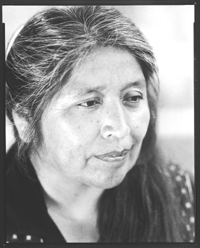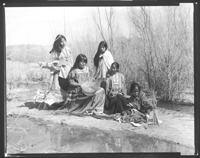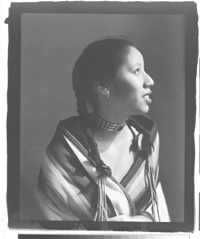From reservation to preservation, Gary Auerbach photographs native America the old-fashioned way.
By Mae Lee Sun
In a time when just about everything in life can be reduced, enlarged, manipulated and replaced within seconds, and often at the touch of a button, local photographer Gary Auerbach has chosen to go big, slow and permanent. Well, at least when it comes to making spectacular sketch-like portraits, landscapes and cityscapes using an 11-by-14 field camera and a chemical "cocktail" of platinum and palladium metal salts.
Seem like a throwback to antiquity? Almost. Old school by today's standards, Auerbach is one of only about 40 photographers of his kind worldwide, choosing to pursue his craft by working exclusively in platinum--a unique handmade printing process, sans darkroom and chemicals, that reportedly has an archival life of 500 to 1,000 years.
Making things last is largely what he feels his work is all about. "I am a photographer, and I do the best I can to take the most telling photographs I can. Most work in photography deteriorates in a relatively short period and I did not want to spend my time working in a form that was going to self-destruct," Auerbach said, referring to the more commonly used silver/gelatin process.
Charly Early, on the photographic arts faculty at Pima Community College (PCC), respects the work ethic that comes with using the large-format camera and hand-coated emulsions, saying Auerbach's, "technique is quite remarkable. Because a platinum emulsion is spread by hand, rather than buying a pre-coated paper, like is done with silver printing, it means the process is slower and more time-consuming." She added that the warmth of the tones is beautiful and rich looking.
The unique and exquisitely detailed images as well as platinum's stability are only a few of the reasons Auerbach's prints are making their way into the private collections of individuals like Walter Cronkite and into galleries and museums across the U.S. and Europe, including the Library of Congress, the Smithsonian, the San Xavier Mission Museum and as part of a permanent display at the Hacienda del Sol resort in Tucson.
 |
|
Portrait of Ofelia Zepeda, by Gary Auerbach, whose platinum prints are reproduced here in black-and-white. |
"When I first saw Gary's work, I was pleased to see the work of old masters being done today, especially when so many photographers are going digital," Battle said. "When his work came up for review, we realized that although we had some images of Native Americans by Edward S. Curtis, there were missing parts. What was missing was contemporary work that wasn't stereotypical, that people wouldn't look at and say 'Oh, that's been done time and time again.'"
Ware agreed, adding that the 25 to 30 prints that will be on display in Dragoon show contemporary Native American people as they are today, an important aspect in the museum's decision to host the show. "We're in our 65th year as an anthropological research institution as well as having a museum and art gallery," Ware said. "We have a lot of old Indian stuff that the public sees, which can sometimes leave them walking away with the impression that Native Americans died out with the buffalo and are no longer with us. Photography presents a real antidote to the general impression that Indians aren't part of the modern world.
"In Gary's photographs, there's an interesting mix of people--mothers, fathers, doctors, lawyers and artists. Some are reminiscent of Curtis' work, but most are people in T-shirts and blue jeans. For me the message is that Native Americans are still here, still vital and keeping their cultural history alive."
 |
|
"Apache Stream," by Gary Auerbach |
"I don't feel this work comments on a certain time in history or is striving to bring a contemporary look at the Native American culture," she said. "There is a sense of antiquity to the prints because of the platinum and this definitely plays a role in the way the images are perceived, just as any materials decision plays a role in a work of art, and how it is 'read.'"
Regardless, Early did acknowledge that the subjects in Auerbach's photos appeared dignified, forthright and interested in having their portraits made, yet questions who the work is for when shown in places like Hacienda del Sol.
 |
|
"Tiffany--Arapaho," by Gary Auerbach |
"I can respect how the artist handled the images, especially in the photos of the elders," he said. "I could make a connection with their spirit like in the photo of Terisimo sitting on an old adobe wall at a cemetery. It showed an elder's place, possibly making his peace and then leaving something to remember him by. Maybe the elder had a purpose in doing that. In my mind, the artist seemed to build up a relationship with him."
Lopez said that he sees a lot of work about aboriginal people that is fictionalized and degrading, but would not say what was or wasn't exploitative without first meeting the artist and hearing what he had to say.
Despite the controversy, some museums that have accepted photographs of Native Americans made only by Native Americans have waived their rules after seeing Auerbach's work. Perhaps it's because he has gone through tribal council offices and has taken his photos with the full consent and knowledge of the people being photographed--unlike some photographers of the past. Auerbach feels he is as honest as he can be when doing this.
"My intention is to show them with respect and beauty as I would with any portrait that I do," he said. "I do not take active political positions regarding my photographs, other than to give my subjects all rights to use these images however they wish. I only ask to be given a photo credit."
For more information on Gary Auerbach's exhibit at the Fulton-Hayden Memorial Art Gallery opening on May 4, contact the Amerind Foundation at 586-3666. Auerbach's work can also be seen on his Web site, www.garyauerbach.com.